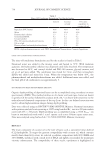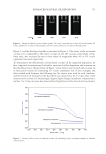638 JOURNAL OF COSMETIC SCIENCE PATHOGENICITY It is important to dig deeper and understand that Malassezia live on sebum, eating the oils on skin (17). Human sebum is created as sebaceous triglycerides that are secreted from the sebaceous gland. When there are few Malassezia, the skin is covered with mostly triglycerides similar to olive oil, which is good for your skin. When Malassezia are present, they break down the triglycerides that are good for your skin, and they are replaced by irritating free fatty acids. We hypothesized if Malassezia cause dandruff, these fatty acids might reconstitute dandruff. To test this hypothesis, we identified two groups of subjects for a clinical trial, one of dandruff sufferers (ASFS 24) and one of non-dandruff sufferers (ASFS 8). We then removed the Malassezia with antifungal treatment and reduced all the flaking scores to 8 and performed a placebo controlled split scalp application of either oleic acid (the most abundant free fatty acid released from sebum) or its vehicle. The subjects who initially had dandruff begin flaking again at the treatment sites, and those flakes look exactly like human dandruff flakes. This indicates that application of a Malassezia metabolite, oleic acid, is able to induce a dandruff-like desquamation. Interestingly enough, in the subjects who did not initially have dandruff, the non-dandruff population, this no longer works. This divides human race into two groups—those who get dandruff and those who do not (15,17). For now, the individual susceptibility remains unknown. It may be a skin barrier problem in which the fatty acids are able penetrate better. It may be a host response to either the fatty acids or to a Malassezia metabolite that has penetrated through the skin. In any event, it is now clear humans can be divided into those who can get dandruff and those who do not. This is termed individual susceptibility and is common in microbially-mediated disease. The concept of individual susceptibility in microbially-mediated disease also complicates how we design, execute, and interpret clinical trials and disease models. If one compares “diseased” to “normal” subjects seeking a causal microbe, if the disorder is based on an underlying individual susceptibility, it will be impossible to find the microbe. It will be present on both groups, unable to cause disease in the nonsusceptible group. Furthermore, the microbe and its entire pathogenic mechanism may be on the nonsusceptible group, simply unable to cause disease. This indicates we need to seriously consider the implications of clinical investigation into microbially-mediated disease. To elucidate the organism and mechanism, it would be essential to work with diseased individuals in which one can treat the disorder and observe changes in the microbiology and homeostatic mechanisms during treatment and reversion (3,11). This also complicates understanding if a microbe is a pathogen, a commensal, or a mutual. Commensalism means that only one of the organisms benefit in this case, Malassezia eat the sebum and digest us with no other effect. All this goes back to Heinrich Koch, a legend of microbiology because of his “postulates of disease” (18). In order for a microbe to cause a disease, it must be found on diseased, rather than healthy, organisms. You must be able to isolate the microbe, grow it up in pure culture, put it back on the healthy organism and cause the disease, and then reisolate it and show it caused the disease. These postulates worked great in the 19th and early 20th centuries, initiated germ theory, and brought about the modern era of medical research. However, the world has now become more complicated (19). Koch’s postulate that organisms must be found on all organisms with the disease, but not healthy organisms, stumbles on the concept of individual susceptibility. Even Koch himself in the early 19th
639 THE ROLE OF THE SCALP MICROBIOME IN HEALTH AND DISEASE century knew there were asymptomatic carriers of tuberculosis, and now, we know that likely more than 90% of microorganisms are unculturable. Today, it is not easy to put disease causing microorganisms back on healthy people, making it more complicated. We need to understand that in all cases Koch’s postulates do not always have to be fulfilled (16). Let us return to this concept of pathogenesis and Malassezia. How can Malassezia cause dandruff if they are on everyone? If we consider susceptible individuals, people who have the possibility of getting dandruff for whatever reason: • If you remove the fungi, the dandruff goes away. • If you remove the bacteria, it does not. • If you remove both the bacteria and the fungi, the dandruff gets better but at the same magnitude as if you removed only the fungi. • If you create a resistant Malassezia and put it back on the same subjects that are under antifungal treatment, that dandruff returns. These were experiments conducted and published in the 1960s and 70s and are high- quality studies (20–22). Additionally, in the experiment in which an isolated toxic metabolite is added back, even in the absence of Malassezia, dandruff returns (15). This makes a pretty strong case that Malassezia can be a pathogen, and we can prove that in susceptible individuals. If one looks exclusively at subjects who are susceptible to dandruff, the pathogenic mechanism can be described: Malassezia is on skin. They eat break down sebaceous lipids by secreting a lipase that breaks down the triglycerides. They consume a subset of saturated fatty acids, actually eating what is good for our skin. They then can proliferate this is a commensal cycle. But that is not how it works. Unfortunately, Malassezia are unable to consume unsaturated fatty acids, and they are left behind on the scalp. They penetrate and break down the scalp’s barrier, inducing a repair response, proliferation, and flaking (13). MUTUALISM (PROTECTION) Mutualism is a relationship in which both parties benefit. A recent example in the human–Malassezia relationship is in atopic dermatitis, a hyperproliferative skin condition characterized by redness, scales, and itching, usually on the appendages or trunk. In a longitudinal study comparing unaffected control individuals, affected AD lesions, and nonlesional sites in affected individuals, Malassezia were compared with shotgun metagenomics. The Malassezia as a group showed little difference. Even with Malassezia restricta, the species most commonly identified on skin, there is no real difference. However, upon examination of Malassezia globosa, the species that is the primary player in dandruff, it was found that there is not that much M. globosa in the lesions, and M. dermatis and M. sympodialis are measurably (but not significantly) higher. In this instance, it was apparent that different Malassezia species have very different activities (23). The hypothesized M. globosa protective mechanism AD involves secretion of an aspartyl protease, MGSAP1. Proteases are designed to break down proteins, and fungi usually employ them to prepare proteins for digestion. So, being a carnivore, Malassezia secretes a battery of proteases to eat our skin. However, it has now been demonstrated in vitro that secreted MFSAP1 is able to break down Staphylococcus aureus biofilms. S. aureus biofilm creation is closely linked to atopic dermatitis. While it is still open as to whether S. aureus biofilms cause atopic dermatitis, they are likely involved, and people with AD lesions have a significantly increased S. aureus
Purchased for the exclusive use of nofirst nolast (unknown) From: SCC Media Library & Resource Center (library.scconline.org)






































































































































